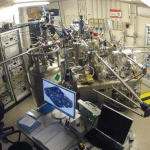Laboratory of Magnetic Materials (LAMM-Lab)
 The research activity of the team is focused on the synthesis, functionalization, and characterization of magnetic materials with particularly emphasis on molecular magnets and magnetic nanoparticles. At present, the main research areas cover: i) the development by colloidal chemistry of biocompatible magnetic nanomaterials for theranostic applications (MRI, magneto-mechanical therapy and magnetic fluid hyperthermia), magnetic-plasmonic nanostructures for high-sensitivity sensors, ferrite-based nanoheterostructures for the realization of rare-earth free permanent magnet (including the use of recycled raw materials) and nano-/micrometric ferrites for high frequency low losses materials. ii) data storage, quantum computing, molecular spintronic and sensing devices obtained by the functionalization of different kind of surfaces (i.e. pure metals, oxide, perovskite) both from wet-chemistry and from Ultra High Vacuum approaches.
The research activity of the team is focused on the synthesis, functionalization, and characterization of magnetic materials with particularly emphasis on molecular magnets and magnetic nanoparticles. At present, the main research areas cover: i) the development by colloidal chemistry of biocompatible magnetic nanomaterials for theranostic applications (MRI, magneto-mechanical therapy and magnetic fluid hyperthermia), magnetic-plasmonic nanostructures for high-sensitivity sensors, ferrite-based nanoheterostructures for the realization of rare-earth free permanent magnet (including the use of recycled raw materials) and nano-/micrometric ferrites for high frequency low losses materials. ii) data storage, quantum computing, molecular spintronic and sensing devices obtained by the functionalization of different kind of surfaces (i.e. pure metals, oxide, perovskite) both from wet-chemistry and from Ultra High Vacuum approaches.

Areas of application
- Nanomedicine
- Permanent magnets
- Spintronics;
- Quantum Computing;
- Catalysis;
- Metallurgy;
- High frequency electronic devices;
- Sensing technology.
Expertise
- Synthesis and functionalization of nanomaterials by colloidal chemistry at lab and large scale;
- Magnetic measurements (ac susceptibility, SQUID and VSM magnetometers, torque, etc..) of magnetic nanoparticles and molecular materials;
- photomagnetic measurements;
- EPR and HF-EPR spectroscopy;
- Magnetic inductive heating capability by calorimetric technique;
- Magneto-optical techniques;
- Single crystal and powder X-Ray diffraction;
- Surface Science;
- Epitaxial growth of metal surfaces;
- Molecular Magnetism;
- X-Ray Photoemission Spectroscopy (XPS);
- Low Energy Ions Scattering (LEIS);
- Low Energy Electron Diffraction (LEED);
- Ultraviolet Photo-Emission Spectroscopy (UPS) and Inverse Photoelectron Spectroscopy (IPES);
- Scanning Tunnel Microscopy (STM), Atomic Force Microscopy (AFM);
- Time-of-Flight Secondary Ion Mass Spectrometry (ToF-SIMS);
- X-ray Absorption spectroscopy and related technique (XMCD, XNLD, XMchiD);
- Synchrotron Mössbauer Source (SMS);
- Electron Transport Measurements;
- Soft lithography process;
- Physical, chemical and plasma vapor deposition (PVD).
Instruments
The group has access to the instrumentation available at LA.M.M. – Laboratory for Molecular Magnetism, Dept. of Chemistry Ugo Schiff, University of Florence, which includes:
 Quantum Design, MPMS SQUID magnetometer operating in the 1.8-400 K temperature range, with AC susceptibility option (0,1 – 1000 Hz), static magnetic field up to 5 T, single crystal rotator and set-up for photomagnetic measurements.
Quantum Design, MPMS SQUID magnetometer operating in the 1.8-400 K temperature range, with AC susceptibility option (0,1 – 1000 Hz), static magnetic field up to 5 T, single crystal rotator and set-up for photomagnetic measurements.- Quantum Design – PPMS equipped with: Vibrating Sample Mode, AC susceptometer (10-10000 Hz), set-up for electrical and magnetic transport measurements, and AFM .probe The instrument operates in the 0-9 T magnetic field range and in the 2-400 K temperature range.
- In-house built Magnetic Heating Equipment equipped with a CELES MP6 generator, operating at 50-450 kHz frequency and up 19 kA/m amplitude for magneto-thermal measurements.
- Oxford Instruments MAGLAB2000 magnetometer: magnetic fields up to 12 T and temperature from 1.6 to 400 K. Equipped with a cantilever probe for magnetic anisotropy measurements.
- Electron Paramagnetic Resonance – X-band E500 Elexsys Bruker spectrometer equipped with a CF helium (4-300 K) and a CF nitrogen (100-500 K) Oxford Instruments cryostats.
- Electron Paramagnetic Resonance – W-band Bruker Elexsys-600 spectrometer operating at 95 GHz with a superconductor magnet at 6 T with split coils, high and low sensibility insert, cryostat with liquid helium-4 with operating temperature range of 4-300 K.
- XPS (X-ray Photo-electron Spectroscopy, SPECS), equipped with a dual anode (Mg, Al) X-ray source and an Al Ka micro-focused and mono-chromatic X-ray source + a 150mm mean radius hemispherical analyser + variable sample temperature (from 100K to 1000K);
- XPS (X-ray Photo-electron Spectroscopy, VSW), equipped with a dual anode (Mg, Al) X-ray source + a 100 mm mean radius hemispherical analyser + variable sample temperature (from 100K to 800K)
- AR-XPD (Angle resolved X-Ray Photo-electron spectroscopy) based on the SPECS XPS setup;
- UPS (Ultraviolet Photo-electron Spectroscopy), based on a UV lamp on the SPECS setup;
- LEIS (Low Energy Ion Scattering);
- LEED (Low Energy Electron Diffraction) SpectaLEED controller;
- Home-made molecular evaporator;
- UHV chamber for molecular evaporation;
- UHV chamber for metal evaporation;
- Home-made spin-coater, allowing a controlled deposition of films via spin-coating with a programmable spinning settings;
- Plasma Vapour Deposition (Magnetron Sputtering) with a high variety of targets.
Permanent Staff
- Martin Albino, Fixed-term Researcher
- Beatrice Muzzi, Fixed-term Researcher
- Lorenzo Poggini, Senior Researcher
- Claudio Sangregorio, Research Director
Other website
https://www.lamm.unifi.it/index.php
